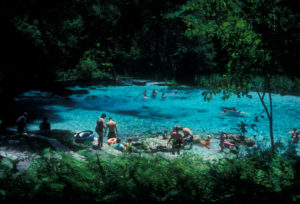
What it means
Why does the Ichetucknee Matter?
by Lucinda Faulkner Merritt
Like a gifted actor, the Ichetucknee plays many roles. This astonishingly lovely and productive ecosystem that has existed for thousands of years is not only a “resource” for us but also a thriving hub of life for other beings. We believe the Ichetucknee should have the guaranteed right to exist and to thrive.
These are some of the roles the Ichetucknee plays:
- Canary in a coal mine
- Ecological role
- Social role
- Economic engine
- Religious/Spiritual role
- Aesthetic role

Canary in a coal mine. Since the springs are the top, visible layer of the groundwater that fills the aquifer, the health of the springs is linked to the health of our drinking water. High nitrate levels in a spring may warn us about high nitrate levels in nearby wells. Low spring flows indicate low groundwater levels.
Ecological role. The Ichetucknee supports the lives of plants and animals in and around the springs and river and provides other ecosystem services such as contributing to rainfall.
Social role. The Ichetucknee is a gathering place for family and community picnics, reunions and celebrations. The river and springs provide recreational opportunities for people of all ages and fitness levels. Ichetucknee Springs State Park is the outdoor classroom and service-learning center for students involved with the Ichetucknee PARKnership program in the Fort White public schools.
Economic engine. The Ichetucknee contributes over $16 million to the local rural economy, a figure that includes job creation and spending by people who visit “the Ich.”
Religious/spiritual role. Local churches have used the Ichetucknee for baptisms. Many people report feeling rejuvenated and spiritually refreshed after spending time in the springs and on the river. In many cultures both past and present, places like the Ichetucknee have been and still are considered sacred.
Aesthetic inspiration. The beauty of the Ichetucknee inspires artists and artisans, writers, photographers, musicians, and other creative people. Many of these people are entrepreneurs and business owners who make money and contribute to the regional economy through the sale of their work. Others create simply for the joy that creating brings them.
